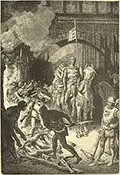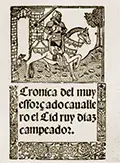El Cid: National Hero of Medieval Spain
The warrior known as El Cid was Rodrigo Díaz and was born about 1043 in Vivar, a small town a few miles north of Burgos, capital of the Kingdom of Castile. He became a national hero and died ruling his own kingdom. 
Díaz, like many young men in Castile at that time, took to fighting the Moors, who had ruled Spain for centuries. Díaz was born during a concerted effort by the Christian kingdoms of the Iberian Peninsula to retake the land from the Moors, a campaign known as the Reconquista. He learned how to read and write and how to fight and ride a horse at the court of Castile, where he had been sent when his father died. He was 14 when he fought in the battle for the key city of Zaragosa and, six years later, also fought in one of several battles for Graus, which eventually fell to Christian armies nearly two decades later. When King Ferdinand of Navarre died, in 1065, he divided up his land among this sons, with Sancho II ruling Castile and Alfonso VI ruling León. The future El Cid, then still named Rodrigo Díaz, fought for Sancho II against the Moors. Sancho died in 1072, and his brother took over Castile; he and Díaz didn't exactly see eye to eye. 
In 1079, Díaz led a contingent of soldiers into Granada and defeated the forces of Emir Abdullah there. However, King Alfonso VI of Castile disapproved of those actions and sent Díaz into exile. The disappointed knight journeyed to Barcelona, offering his services to Ramon Berenguer II. The count refused. Angry, Díaz offered to fight for Yusuf al-Mu'taman ibn Hud, the Moorish King of Zaragoza. This leader accepted, in 1081, and it was there that Díaz gained the name El Cid (The Master). The Castilian soldier served his Moorish leader well, leading his troops into battle for nearly a decade, including against the forces of Sancho I of Aragon and Ramon Berenguer II, who had earlier spurned El Cid's services. Alfonso ended his exile, and El Cid was briefly again at Alfonso's side, after a Muslim victory at Sagrajas in 1086. However, the Castilian knight had his sights set on ruling Valencia and so eventually fought for neither Alfonso nor his opponents, the invading Almoravids. El Cid found himself again exiled. He had married Jimena in the mid-1070s; and by the time of this second exile, they had three children. Alfonso VI sent El Cid away and decreed that Jimena and the children be imprisoned. 
At the head of a determined force of his own, El Cid captured Berenguer himself at the Battle of Tébar in 1090. Continuing on their campaign, the troops of El Cid besieged Valencia and claimed a swathe of land on the Mediterranean coast. By 1094, he was Prince of Valencia, the ruler of a peaceful city in which Christians and Muslim coexisted. An Almoravid army besieged the city more than once. The first time, in 1094, the wily Prince of Valencia decided not to stay within the walls and defend but, rather, to ride out onto the field of battle. In a surprise attack, the Valencia forces won the day with a heavy cavalry charge, scattering an army several times their size. The attackers returned in 1099, and El Cid died during that siege. His wife, who had recently joined him, ruled after him, continuing to organize the defenses. She eventually fled the city, going to Burgos in 1101. The city fell the following year. 
Jimena Díaz had carried her husband's body with her on her trip to Burgos. There he still lies, in Burgos Cathedral, after a brief burial in the monastery of San Pedro de Cardeña. He and Jimena had three children: Diego, Cristina, and María. El Cid is also known as El Campeador (Battlefield Master). His name is sometimes written Cid Campeador. He has become a popular figure in film, literature, music, and video games. |
|
Social Studies for Kids
copyright 2002–2024
David White




